When there’s no time to light up the stove, then there’s the Hammer tower: carbo/protein mix and electrolytes mix! With a friendly 15% discount from Ginjer at Hammer Nutrition.
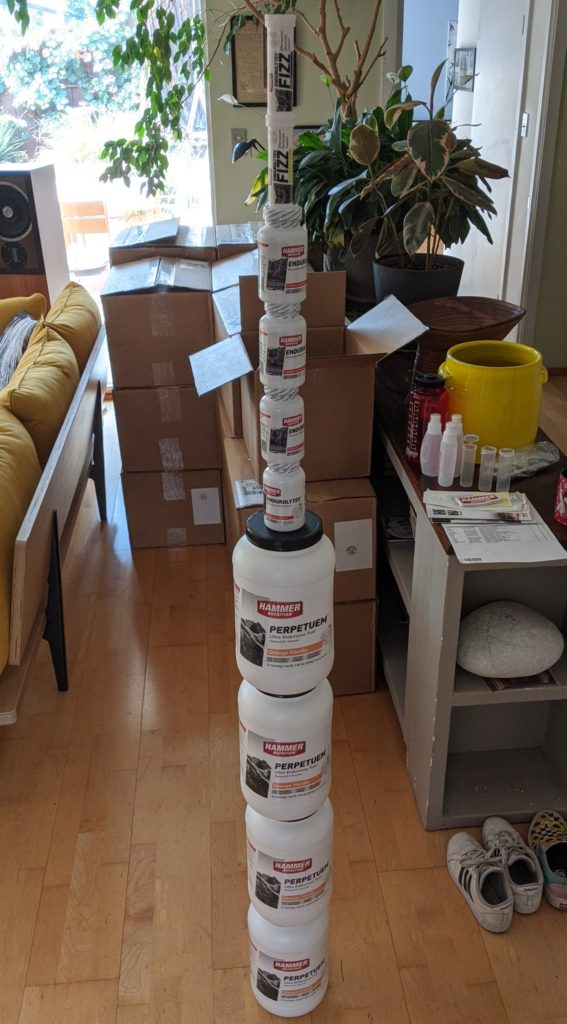

An attempt at circumnavigating Earth on a small sailboat
Sailing from San Francisco to San Francisco
When there’s no time to light up the stove, then there’s the Hammer tower: carbo/protein mix and electrolytes mix! With a friendly 15% discount from Ginjer at Hammer Nutrition.

If bankers were still calling their customers, I’d probably be receiving a few phone calls. But we’re nothing now to financial monster corporations, which hold our money. So I can just hit submit and forget about it. Expenses have been accelerating these days: $4,000 for food, $2,400 for a registration, $2,500 for electricity generation, there’ll be the fat boatyard bill, and the usual tons of incidentals (tools, clothing, spares, stuff). This is where a sponsor would help … Or donations. It sounds like going back to work when I’ll be back is not going to be an option! As if it ever ever was … who am I kidding?
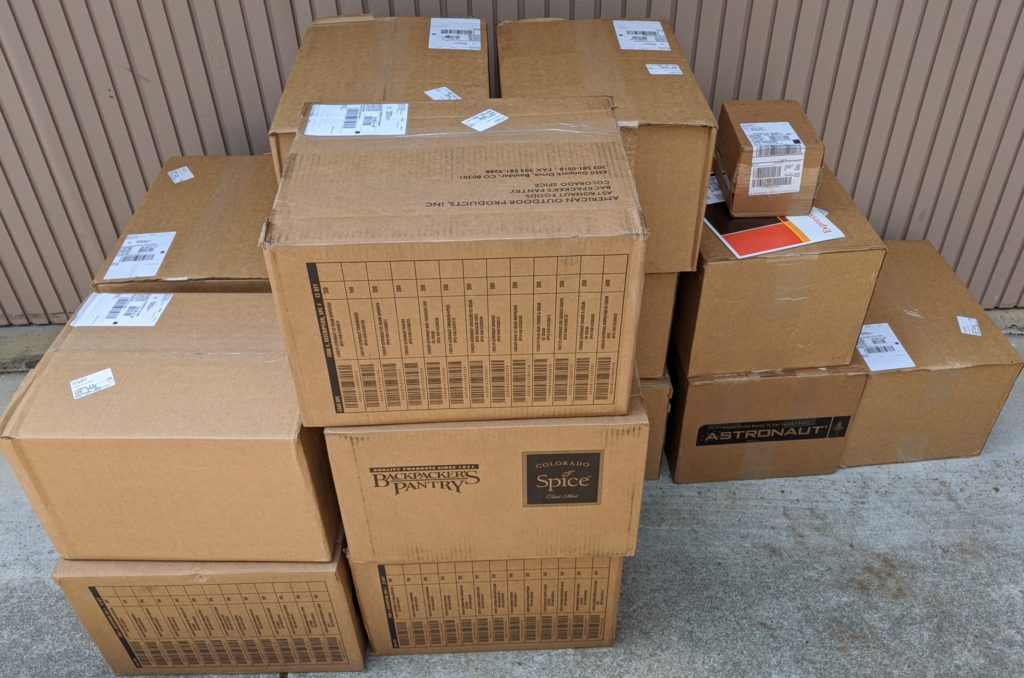
I just received most of the freeze dried food. And now the puzzle begins. I mean how will I stick all this in the boat, in a somewhat organized fashion? I can barely move in my office what with all the bags and cases lying around: JetBoil fuel cans, spare hydraulic oil, wipes, foul weather gear, clothing, spare rope, spare electronics, spare solar panels, not mentioning all the stuff that is already on the boat, nor the small/medium water containers. Things are spilling over into the garage and living room. It’s going to be interesting trying to stay organized! And there’s more coming: sport supplements from Hammer Nutrition, a small spinnaker.

I have refrained from buying good stuff, you know, like candies, cookies, snack bars. I’m trying to reduce exposure to sugar. I’ll admit that I did get a lot of freeze dried deserts. But that’s only crème brûlée, chocolate cheesecake and mango sticky rice, all nice and slushy like freeze dried food is. So it’s sweet but not crunchy. Oh, and I should be getting freeze dried ice cram, courtesy of my friend Jackie!
Comfort food can be important in that it is a source of … comfort. So I’m not sure what I’ll do in the end. Snack bars are definitely going to be required; I just haven’t found the right ones yet.
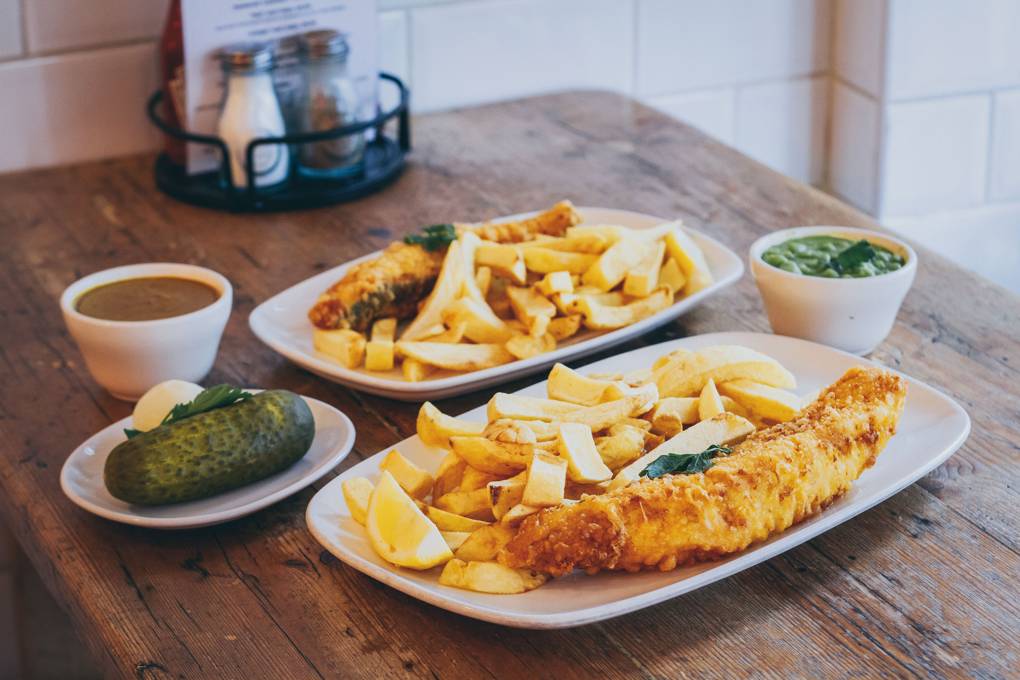
If I get sick or hurt, I’d prefer to not have to bail out. So with the help of Jackie we’re putting together a pharmacy kit. I got the prescription meds yesterday (another $350 goes kaboom). I’m not sure how I’ll organize that either, nor if I’ll be smart enough to figure out what to use when.
In both my long distance trips, I experienced injuries. During the South Atlantic crossing, it was an eye scratch. And during the SHTP, I lost a tooth filling. So it is likely that something will happen. That said, let’s be positive, the doctor said I’m in good health!

The team at BMC has been busy finishing preparing the hull for paint, and improving the situation around the keel box to hull junction. There has also been conversations about replacing the port V1 shroud. If all goes well we should be splashing Changabang end of next week, with a brand new, super slick bottom. I look forward to seeing an improvement in boat speed!
That’s all for now! Oh no, one more thing, I converted all my old CDs to mp3 and dumped that on a flash drive. And I also downloaded a few guided meditations. No movies, no books, is it going to be a boring adventure?

I thought it’d be wise to do a quick health check before leaving. After a few blood and stool (the joys of turning 50 are just around the corner) tests, it appears everything is boringly normal. I had teeth cleaned up too. In fact, my main concern for this sailing voyage is my dentition. My teeth are always borderline sensitive; they often make themselves known. With the soft freeze dried food, I hope all will be all right. I’ll certainly be ready to do a temporary filling. I need to remember that during the SHTP I lost a filling!
Other than that I’ve finally gotten back into running (ok, walk, running, really). So I feel like my level of fitness is improving.
All good news so far then. I even have what may be a final job interview on Tuesday (speak of being indecisive, or would it be more like keeping options open?!?).
On August 21st last year, Changabang and I met for the first time. It took many steps but then she was here. And now we’re D-50 from departure (that’s variable of course). Time flies; are we ready? Not yet …
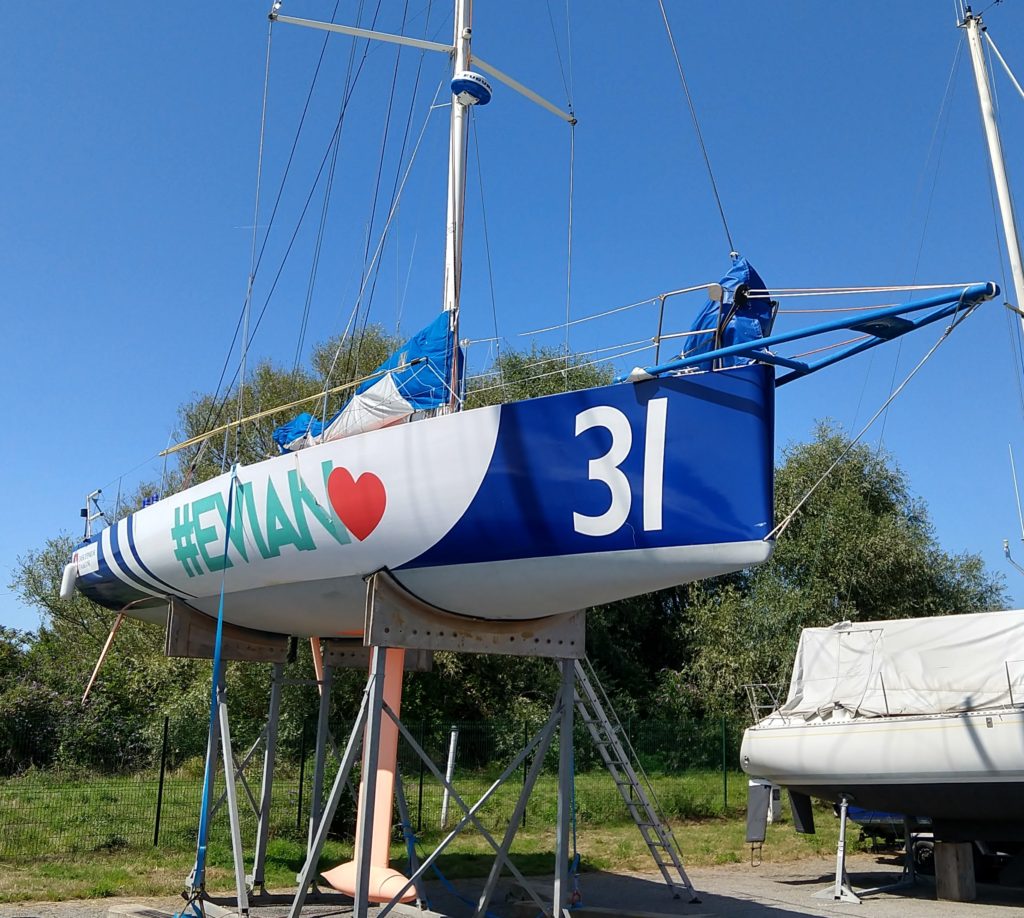
On 8/12 I left Half Moon Bay to sail to the Berkeley Marine Center (BMC). I left with no wind, and motored for several hours before hoisting the sails and enjoying a wonderful, soft, upwind ride up the coast. When we got into the Bay the wind had climbed up to 18-22 kts. BMC is located in the Berkeley Marina, which is in a shallow area. My plan was to wait until high tides around 5PM to make my entrance. But I was there early so I dropped all sails, and made my way slowly through the shallows, doing 3.5 kts with no engine and no sails, closely monitoring the depth. 3 feet, 2 feet, 1.5 feet. We were clearing the bottom just fine when we arrived at the marina entrance so I decided to go in. I moved about to get the fenders in place, and stopped watching the depth meter. And, of all place that could easily be dredged, I ran aground in the marina entrance, with rock jettys on both sides. Not exactly a great prospect. Tide was rising, so that was good.

I tried powering up the engine in reverse or forward, but all that did is get me stuck deeper. My friend Jacky was waiting to help with the docking, and also had mentioned having banana bread in her purse. Damn, so close but so far. I proceeded to tidy up things on deck (might as well put time to good use), until a fellow on his dinghy came along proposing to help. I declined as I didn’t think he could much. He was insistent and started pushing the bow. With some engine power we then managed to clear things out. And so, finally, we got into the fuel dock, where the water was deep enough.
The original plan was to haul out the next day. But I was there, the BMC crew was there, so Cree, the owner, told everyone to haul us out a day ahead. In my little time with CaB, she’s been in the lifts more time than I thought reasonable! To get in the water in Frossay, to get on the quay in Antwerp, to get on the cargo ship in Antwerp, to get off the cargo ship in San Diego, and now to get the keel looked at and the bottom painted in Berkeley.
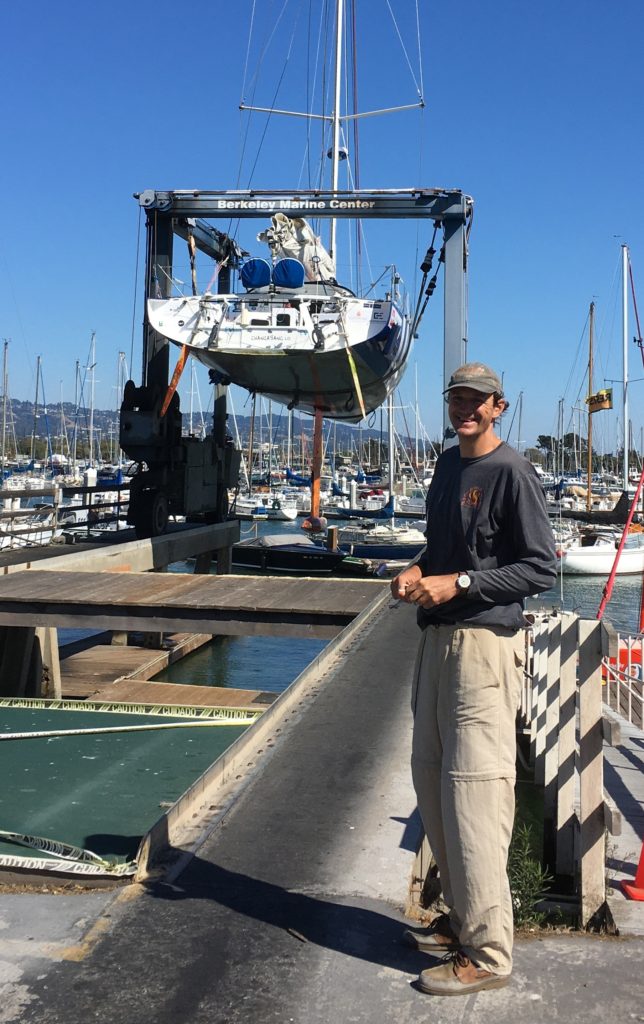
Things went well, and an hour later Changabang was resting in a keel pit. She attracted attention, being a racy boat and what not, which always leaves me uncomfortable, not being a racy skipper and what not, hitting above his weight, etc. (says the monkey on my back).

I slept on the boat that night, waiting morning to discuss work on the boat.
Confirming that the keel was good to go for a circumnavigation was an essential reason for my visit to BMC. We could see that the crack that was repaired in France, was in fact still there. Whatever putty was applied didn’t seal anything; water could be seen at the edge of the cracks. So there was, as we knew, water in the keel well. I spent the better part of the day hammering two keel bolts. We found them in good standing for the most part, with one slightly corroded. Over the next few days lots of material was sanded out to expose the crack and see if anything else was brewing.


Cree of BMC says the keel is not going to fall, and PJ of CaB starts spending money again! There is still work to be done, for sure, as this picture shows but all in all, when we leave the boatyard, we should be in a better position than when we arrived.

That first day on the yard, Sylvain of UK Sailmakers showed up to make measurements for the sail that will be funded by the Ocean Cruising Club. Sylvain has been very helpful in my early days with CaB; he’s even helped shorten the maxi spi hoist. I really look forward to hoisting a new sail on Changabang! It should be ready mid/late September.
A few days later Brian of Pelagic autopilot showed up to discuss placement/installation of his autopilot. Brian is always so helpful. He helped me quite a bit with my preparation for the 2018 SHTP. Once this complete system will be in place, I’ll have 3 fully independent self steering solutions: the old (and trusty?) B&G, the new’ish NKE (which hasn’t (yet) really proven itself on long distance sailing, on CaB that is), and the Pelagic. I also have a spare hydraulic actuator, which can be used by all 3 autopilots. I hope this will be enough, but we shall see.
One thing I discussed with Cree was the need for a fiberglass/carbon/and more repair kit. “Chemical” Dave at BMC made a fantastic proposition, which he even took the time to demo. That was really great! I hope to never have to use the kit, but if I have to, it feels like it is something that even this two left hands boat project guy may be able to do!
All in all it’s been a good experience so far, with Ruben helping me with my questions as his day flies by.
Confirming that the keel would be good for the trip was a key turning point for my bank account. I submitted fees to the WSSRC for the record attempt (about $2,400). I bought loads of freeze dried food (about $4,000 as Backpacker’s Pantry back pedaled on their originally generous discount, settling down to only 20%), and more incidentals. Meanwhile the GoFundMe page saw a $65 donation, for which I’m grateful of course. If you have read this far, would you consider a small donation, please?
There is hope that Changabang will leave the yard end of next week, maybe a little later. On the way back to HMB, I’ll be testing the Pelagic auto-pilot. Once back in Pillar Point Harbor, it’ll be time to prepare Changabang for departure (cleaning, loading, and a few test sails with everything aboard). And then … setting sails for a little voyage!
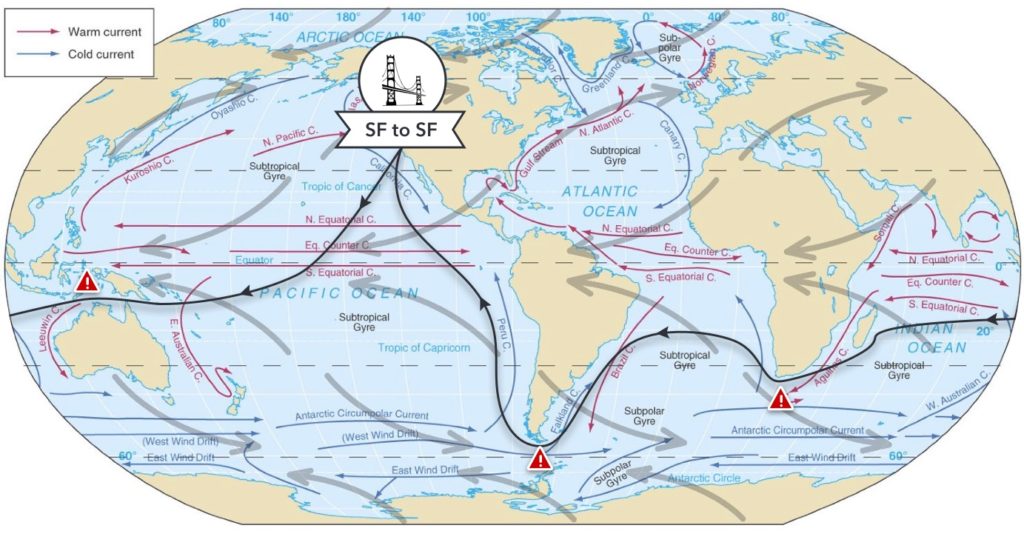
Sorry, no picture/video yet.
We’re about 2 months away for the scheduled 2020 departure. Next week we’re hauling out Changabang at Berkeley Marine Center, Thursday in fact. I think it will be a decisive moment as it will give us an opportunity to look at the keel. There’s still a small possibility that I would delay one year, mainly because repair costs would be prohibitive (and I’d have to go back to work to make up for it). Fingers crossed!
It is time to take stock of what I’ve done so far. To put things in context the Vendée Globe organisation now requires aspiring skippers to complete a 2,000 NM qualifying sail. My longest sail in Changabang was about 400 NM, which is a little less than I’d have hoped for. This was partially dictated by lighter winds off Half Moon Bay than usual, and also because I do have to spend time in other areas, mainly skipper/boat preparation.
I think my approach to this preparation was mostly based on a couple of things I learned from my reading and personal experience, as well as the specifics of this voyage:
Surprisingly there are still more things on the list than I would care for at this time: getting a fully functional hydrogenerator setup (port and starboard, plus spare), installing an above deck autopilot, testing a spare below deck autopilot (and replace hydraulic oil in all 3), getting a new spinnaker.
When Changabang comes out of the boatyard (hopefully before September begins), it’ll be urgent to tick off the above items off the list. That’s because then the departure checklist will start: clean up, provisioning, organizing, etc, and getting my shore life in order to depart for 6-8 months. Judging by the pace at which things are moving, I hope somewhere along the path we’ll see some acceleration!
For some reason I had never been afraid when going sailing. But … I read one more story of a circumnavigator, that of Alain Colas. He speaks of his fear in ways that somehow resonated with me. When I went sailing after reading his book I was uneasy about everything, for several hours. Then I put a bit of music on and things settled. But, yes, I do not know how I’ll feel when I’ll have to run in front of 30 feet waves in 60 kts of wind, with a sideways swell, the autopilot craps out and the jib halyard blows out. Side note: Alain Colas and his boat disappeared at sea, both never to be found.
Considering that I may leave on 10/10, it’s only two months left now. To a certain extent, and assuming the lists above get done, I feel, mmmh, about 80% ready.
Thanks to the suggestion of Randall Reeves of the Figure 8 Voyage, I applied for a grant from the Ocean Cruising Club. If you’re into crazy projects, then do check Randall’s story. That is/was something! Such a bold accomplishment!
So, back to the grant, I put together a document to share my intentions, and asked for a bit of money to buy a spinnaker. I’m happy to report that the grant committee did see something worthwhile in my project. As a result I’ve been awarded a grant, which I will put to work in the next few weeks. My heartfelt thanks to the Ocean Cruising Club!
I also saw a donation to my GoFundMe campaign. So, on the topic of money, may I encourage you to help fund this project. You can donate online here. I know it’s not exactly the right time to ask for money; so I will just say that the other Belgian seeking to circumnavigate Earth did manage to raise a little over 5,000 EURO.
In other news, the winds off the Half Moon Bay coast have been very light. I’ve not been able to do much practice. Instead, I’ve been doing small boat projects, repairing things here and there, upgrading suspect hardware, identifying and purchasing spare items, etc.
That is all for now. Hopefully, next week, the wind will fill back in, and I’ll have a few videos to share.
Stay healthy.
I’ve scheduled the haul out of Changabang for mid August. She’ll get a new bottom paint, and we’ll have a closer look at the keel. Once that’s done, I’ll know for sure if leaving this year will be ok.
In addition, I’ve confirmed the start/finish line with the WSSRC, should I sign up for a record attempt (foolish, ain’t it?!?). It’s almost as simple as “pass under the Golden Gate bridge”.
I’ve looked at possible start dates as well. I’m thinking of sailing into San Francisco Bay on Friday 10/16 (probably staying at South Beach Harbor, unless I get an offer from another marina with enough depth), and depart Sunday 10/18 after an early lunch, benefiting from an ebb tide. Of course this is all weather dependent. I may also move everything up by one day and depart on Saturday.
This past week has seen light winds off the Coast but things should lively up again Monday. I’m planning for another shakedown cruise leaving tomorrow then. The brand new Watt & Sea hydrogenerator had to be shipped back to France as the seal failed (and there may be more to this too).
I’ve been testing, as you may have seen, posting to the blog via email. I think I have a good solution now. We’ll see.
That’s all for now. All the best.
Changabang is back in Half Moon Bay. You may remember that the boat was in Richmond to get the hydrogenerator brackets installed. That was completed yesterday late afternoon, after which I spent much time in uncomfortable positions installing the hydrogenerators themselves.

This is the biggest upgrade and budget item on my list. I’m glad to see it’s done and is now ready for full on testing.

The sail home was long. I departed Richmond with winds blowing in the low 20s; so I opted for the 3rd reef. Once I got into the Bay it came down to 6 kts building back up to 18 kts. It was also flooding and the wind was on the nose. So I chose to motor because it was a dark, foggy night. I didn’t want to have to tack my way across the Bay. There was one scary moment when I realized that a cargo ship was crossing just ahead of me. It was so dark that I had not seen it. I don’t think we would have collided but it was a short call and I kept my eyes peeled thereafter. Passing under the bridge took forever as we were fighting about 2.5+ kts of flood current. With the fog we enjoyed drizzle all the way home almost.
Once I turned South the wind was down to 10-12 kts, and we were upwind. It was a long slog home as I only had the staysail up (the solent went in for repair and is not ready for prime time yet). It was 5:30 AM when I laid down in my berth.
That is all for now … More work tomorrow.
Yesterday I sailed Changabang to Richmond, where she will get a couple aluminium brackets implanted on her stern. These will be used for the hydrogenerators. I am fairly excited about this because once that is in place, I’ll be ready to go out for a first “shakedown” cruise, with the hope of testing as much as I can.

The forecast for the sail up to Richmond called for 20 kts. But as usual it was +/- 10 kts, and this time it was “-“. Around 11 am noon, the wind picked up and started shifting so I hoisted the gennaker. We were heeled quite a bit (i.e. overpowered) when I noticed a rip in the foot of the sail. After I struggled a little to furl the sail back in (and learned something new in the process) we carried on with staysail and mainsail only thereafter, with the wind continuing to build up to 27 kts when I came under the Golden Gate Bridge. We were sailing against an ebb so progress wasn’t very fast. We did enjoy a few surfs, sometimes burrowing into the wave ahead. Top average GPS speed over ground was 12.8 kts (in 1.5 kts of adverse current I think at that time).
Once in the Bay I took the gennaker down, hoisted the code 0’ish and moved towards my destination. What else happened? We didn’t hit anything. I tried to prepare a hot chocolate. As the conditions were benign at the time I was not keeping a hand on the JetBoil; unfortunately a little wave came along, heeled us little more, and the top heavy setup spilled over me. Glad the water wasn’t much hot yet. Lesson learned: always boil with my hand holding that thing! I will also look into a gimballed setup. I did finish preparing that hot chocolate drink!

In Richmond I was welcomed with cookies by my friend Jackie, who also helped me home. We discussed the boat, the plans, and not the least the pharmacy kit aka “how to put Humpty Dumpty back together” box.
That’s all for now … Waiting …
I think it’s time to take stock and see where I am. Have odds improved? Let’s start with time.
As indicated elsewhere timing calls for a departure mid October, which assumes an average boat speed of 7 kts. Granted Changabang is a fast boat and even a bump to a 7.5 kts average speed would allow us to depart 3 weeks later. So, there’s a bit of wiggle room with the start date.
Regardless, I am considering allowing one month for final preparation and loading. Before that Changabang will get a new bottom paint in the boatyard, for which I’m generously allocating one month too. That means that we need to be ready by mid August. Considering we’re about mid June, that leaves me with two months. I feel good that, based on what I plan to do, I will be able to leave this year.
In the order of importance, I see the following: a safe passage making sailing vessel, a strong electrical system, redundancy in self-steering and navigation means. The rest I see as gravy.
From what I have been able to identify and experience, Changabang is doing solid in this category. The remaining weaknesses are: a (slow) leaking internal ballast system (it’s never good to have a leak in a boat); a keel bolt and damage that would benefit from further investigation. These two items can only be addressed when the boat will be out of the water, which is why I am allowing one month for the one week bottom paint job.
The running rigging is a bit of a weak point. I am not going to address it before leaving. My plan for now is to buy a spool of excellent line and replace as necessary.
What makes a sailing vessel safe is the ability of the skipper to handle the boat in all conditions. I am not going to be able to experiment in all the sailing conditions I will encounter. So this will be a weak point of my preparation, with hopefully strong improvements as I learn during the first few thousand miles.
Electricity generation will be left to Watt & Sea hydrogenerators, one to port and one to starboard. I’ll have a spare generator and about 4 propellers. I hope these will last the whole trip. The installation is not complete yet but should be in a couple of weeks. Testing after that, during a shake down cruise, will reveal if all is good.
Electricity is stored in 3 lead acid batteries. In a perfect world, I would have them tested for health, and I may still do that. But replacing them is unlikely What I will do though is purchase an additional battery. If those I have fail then I’ll swap them out.
I also have 275W of solar panels and a diesel engine with a 115A alternator. I’ll leave with about 80 liters of diesel, which would be good for about 20 hours of charging.
In conclusion, we’re almost ready here, unless the hydrogenerators fail the real life test.
Sadly I just discovered a major weakness in one of the two auto-pilots. They require a rudder angle sensor. The installers in France did something fairly stupid: they installed a non waterproof sensor outside! So I need to replace that, which will cost me about $600+. And I’d do well to have a backup but I don’t think I’ll spend that money.
I will try to get a used Lecomble & Schmitt auto-pilot for parts as well. I do need to replace the hydraulic oil in these two systems. The secondary system is old.
I plan to install an above deck autopilot too. So, all in all, the situation here is not too bad. With a spare rudder angle sensor it would significantly improve though.
I do think that I have addressed this fairly well several months ago. So I’ll consider this as 90% complete.
I feel like a departure this year is still highly possible.